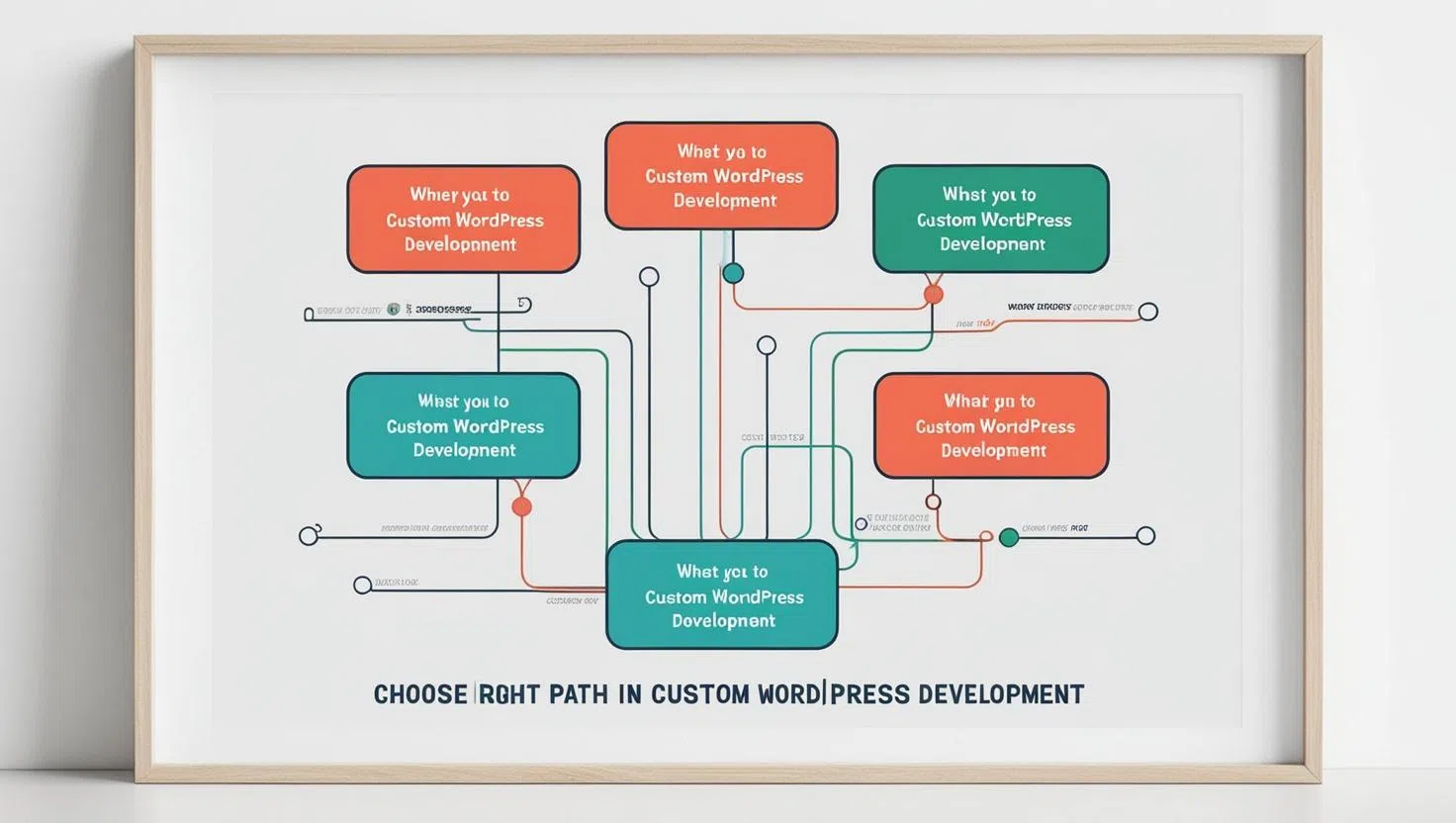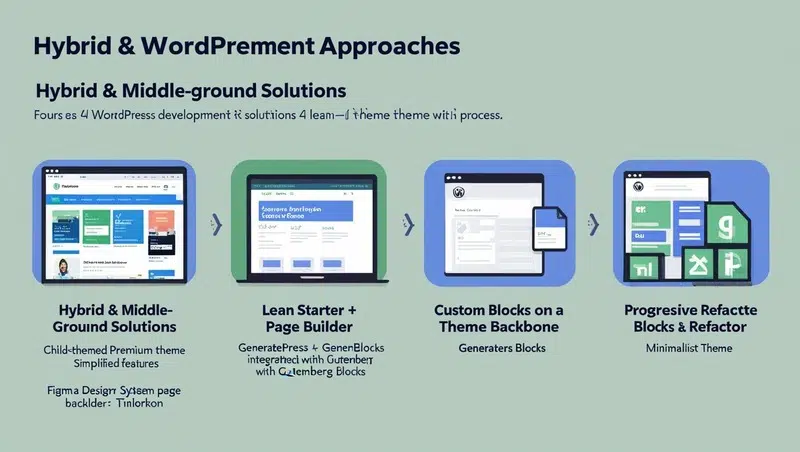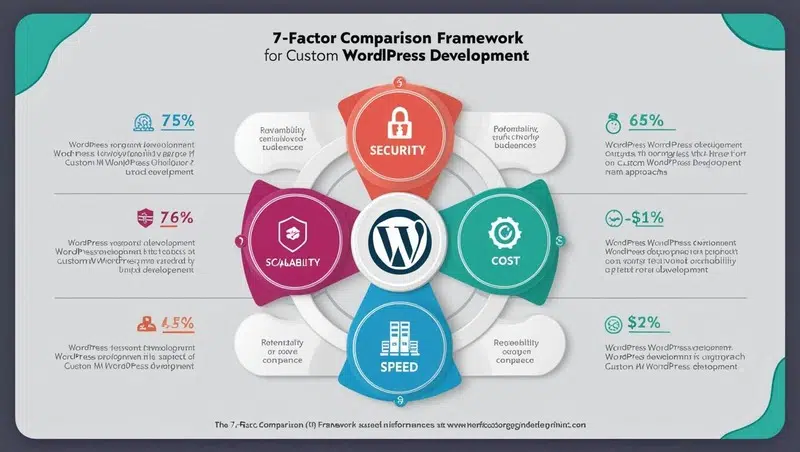1. Introduction
The WordPress ecosystem has exploded: from headless frameworks and full-site editing to thousands of page-builder kits
on ThemeForest. In 2025, businesses still wrestle with the “custom vs. theme” choice because it represents a bigger
question: Do you need optimization for today’s launch checklist or for tomorrow’s growth graph? This article
gives you a rigorous decision path—grounded in real-world data, not hype—to ensure you invest in the right foundation.
2. Defining the Options
2.1 What Counts as Custom Today?
- Blank-Slate Builds – Designers craft each and every pixel,
developers code bespoke templates, functions, and Gutenberg blocks. - Headless WordPress – WP for backend plus React/Vue front-end,
decoupling content from presentation for app-level performance. - Bespoke Plugins &
Integrations – Custom APIs, membership logic, or e-commerce flows that marketplace plugins can’t
handle. - Starter Frameworks – Sage, GeneratePress, or Underscores,
trimmed to essentials, then expanded precisely for your brand.
2.2 What Are Pre-Built Themes?
- Marketplace Themes – One-size-fits-many packages with demo
imports and drag-and-drop styling. - Niche Kits – Vertical-specific themes for gyms, law firms, SaaS,
etc., bundling generic plugins and demo content. - Page-Builder Packs – Elementor/Beaver/Bricks template libraries
that promise “site in a day” simplicity.
3. The 7-Factor Comparison Framework
3.1 Cost & Up-Front Budget
- Custom: Higher initial spend (design, dev, QA) but tailored code
avoids license creep. - Theme: <$100 for a license plus setup hours, yet paid add-ons
accumulate quickly and may equal—or exceed—custom over 2–3 years.
3.2 Time-to-Launch
- Custom: 4–12 weeks is normal; more for advanced apps.
- Theme: Same-week launches possible—but expect rework once real
content collides with demo layouts.
3.3 Design Flexibility & Brand Uniqueness
- Custom: Infinite. Your brand guidelines shape the grid,
typography, motion, and micro-interactions. - Theme: You start with someone else’s brand DNA and wrestle to
“on-brand” it. Eventually you hit hard-coded walls.
3.4 Performance, Core Web Vitals & SEO
- Custom: Only what you need ships. Clean code, lean CSS/JS, tuned
LCP and CLS; easier 90+ Lighthouse scores. - Theme: Bundled sliders, icon fonts, and WYSIWYG overhead balloon
requests. You’ll often need extra optimization work.
3.5 Scalability & Feature Roadmap
- Custom: Architecture anticipates new modules—membership,
multilingual, CRM sync—without plugin spaghetti. - Theme: Each new feature risks plugin conflicts or design
mismatches. Refactor costs grow exponentially.
3.6 Security, Updates & Technical Debt
- Custom: Fewer moving parts; dev team owns the code and patches.
- Theme: Relies on third-party vendors keeping theme + bundled
plugins secure. One abandoned add-on can expose the site.
3.7 Ongoing Maintenance & Total Cost of Ownership
- Custom: Predictable—update WordPress core and your own codebase.
- Theme: Recurring license renewals, page-builder updates, extra
caching/CDN to compensate for bloat.
Side-by-Side Snapshot
| Factor | Custom Build | Pre-Built Theme |
| Initial Cost | $$$ | $ |
| Launch Speed | Medium | Fast |
| Brand Uniqueness | Complete | Limited |
| Performance | High | Variable |
| Scalability | Future-proof | Constrained |
| Security | Code-controlled | Vendor-dependent |
| TCO (3 yrs) | Stable | Rising |
4. Decision Matrix—Which Path Fits Your Scenario?
Answer “Yes” or “No” to each question.
If you collect 3+ “Yes” in a column, that’s your strongest fit.
| Question | Custom | Theme |
| Need unique UX to differentiate? | Yes | No |
| Plan >3 feature rollouts in 18 months? | Yes | No |
| Budget <$2 k & launch deadline next month? | No | Yes |
| Expect traffic >100 k monthly & tight SEO goals? | Yes | No |
| Comfortable relying on many third-party plugins? | No | Yes |
5. Hybrid & Middle-Ground Solutions
- Child-Theming a Premium Theme – Strip out features, rebuild templates, keep core update path.
- Lean Starter + Page Builder – Use GeneratePress + GenerateBlocks
for near-custom performance with GUI convenience. - Custom Blocks on a Theme Backbone – Design system lives in
Figma; Gutenberg blocks coded to match, layered onto a barebones theme. - Progressive Refactor – Launch on a theme, collect revenue,
budget phase-2 custom rebuild without harming SEO.
6. Mini Case Studies
Case 1 – High-Growth SaaS (Custom)
- Goal: Multi-tenant marketing site, gated resources, and product
docs. - Build: Tailwind-powered custom theme, REST API to app, Algolia
search. - Results: 96+ Core Web Vitals across global PoPs, 300 % traffic
growth, 30 % lower bounce vs. old Drupal site.
Case 2 – Local Bakery (Theme)
- Goal: Affordable rebrand before holiday rush.
- Build: Niche Elementor kit, WooCommerce product grid, Stripe.
- Results: Site live in 10 days, 2× online orders YoY. In year 2
they hit page-builder fatigue and began budgeting for custom refresh.
7. Common Myths Debunked
- “Custom always costs a fortune.” Modular development,
open-source libraries, and modern build chains have slashed custom overhead. - “Themes are automatically slow.” A well-vetted lightweight theme
(e.g., Blocksy, Astra) can hit 90s—but only if you resist plugin overload. - “You can’t scale on a theme.” You can, but cost balloons:
more performance band-aids, more QA with each update. At some traffic threshold it’s cheaper to rebuild.
8. Conclusion & Recommendation
If your site is a short-term marketing experiment or you urgently need an online brochure, a pre-built theme is
the pragmatic choice—as long as you accept its shelf-life.
If your website is core to revenue, requires distinctive UX, or must integrate deeply with other
systems, invest in a custom build or a hybrid starter. The additional up-front spend is dwarfed by savings in
performance tuning, brand equity, and future features.
9. Call to Action
Feeling stuck? At DazzleBirds, we audit your goals, content, and tech stack, then map out the ROI of custom vs.
theme—free of charge. Book a 30-minute discovery call, and let’s architect a WordPress foundation that actually
compounds value.







